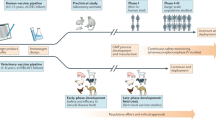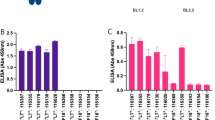Abstract
The discovery, development and marketing of animal health anti-infective products are at an important crossroads. Traditional anti-infective products include antibiotics, parasiticides and vaccines, which are administered to either food production or companion animals. The convergence of market conditions, new regulatory guidance, political decisions and food safety concerns has led to a redirection of research away from traditional antibiotics and towards other products that have an increased probability of acceptance in the marketplace and shareholder return.
This is a preview of subscription content, access via your institution
Access options
Subscribe to this journal
Receive 12 print issues and online access
$209.00 per year
only $17.42 per issue
Buy this article
- Purchase on Springer Link
- Instant access to full article PDF
Prices may be subject to local taxes which are calculated during checkout
Similar content being viewed by others
References
Phillips, R. Sales of animal health products show modest gain in 2002. (Animal Health Institute, Washington DC, USA) [online], (2002).
Meinke, P. T. Perspectives in animal health: old targets and new opportunities. J. Med. Chem. 44, 641–659 (2001).
Moore, A. S. & Kitchell, B. E. New chemotherapy agents in veterinary medicine. Vet. Clin. North Am. Small Anim. Pract. 33, 629–649 (2003).
Evans, T. & Chapple, N. The animal health market. Nature Rev. Drug Discov. 1, 937–938 (2002).
Agres, T. Doggy drug targets push research prospects. The Scientist 17, 52–53 (2003).
Phillips, I. et al. Does the use of antibiotics in food animals pose a risk to public health? A critical review of published data. J. Antimicrob. Chemother. 53, 28–52 (2004).
McDonald's global policy on antibiotic use in food animals. [online], (2003).
Proceedings of the Biannual meeting of the American Academy of Veterinary Pharmacology and Therapeutics [online], (2003).
Fox, J. Gloomy forecast regarding efforts to develop new antibiotics. ASM News 69, 588–589 (American Society for Microbiology, Washington DC, 2003).
Nelson, R. Antibiotic development pipeline runs dry. Lancet 362, 1726–1727 (2003).
Rochette, F., Engelen, M. & Vanden Bossche, H. Antifungal agents of use in animal health — practical applications. J. Vet. Pharmacol. Ther. 26, 31–53 (2003).
Singh, M. & O'Hagan, D. T. Recent advances in veterinary vaccine adjuvants. Int. J. Parasitol. 33, 469–478 (2003).
Lowenthal, J. W. et al. Avian cytokines — the natural approach to therapeutics. Dev. Comp. Immunol. 24, 355–365 (2000).
Streatfield, S. J. & Howard, J. A. Plant-based vaccines. Int. J. Parasitol. 33, 479–493 (2003).
Geary, T. G. and Thompson, D. P. Development of antiparasitic drugs in the 21st century. Vet. Parasitol. 115, 167–184 (2003).
Harder, A. & von Samson-Himmelstjerna, G. Cyclooctadepsipeptides — a new class of anthelmintically active compounds. Parasitol. Res. 88, 481–488 (2002).
Willadsen, P. The molecular revolution in the development of vaccines against ectoparasites. Vet. Parasitol. 101, 353–367 (2001).
Dalton, J. P. & Mulcahy, G. Parasite vaccines — a reality? Vet. Parasitol. 98, 149–167 (2001).
Allen, P. C. & Fetterer, R. H. Recent advances in biology and immunobiology of Eimeria species and in diagnosis and control of infection with these coccidian parasites of poultry. Clin. Microbiol. Rev. 15, 58–65 (2002).
Bowles, V. M. et al. Vaccination of sheep against larvae of the sheep blowfly (Lucilia cuprina). Vaccine 14, 1347–1352 (1996).
Meeusen, E. & Brandon, M. R. The use of antibody-secreting cell probes to reveal tissue-restricted immune responses during infection. Eur. J. Immunol. 24, 469–474 (1994).
Knox, D. P., Redmond, D. L., Skuce, P. J. & Newlands, G. F. J. The contribution of molecular biology to the development of vaccines against nematode and trematode parasites of domestic ruminants. Vet. Parasitol. 101, 311–335 (2001).
Knox, D. P. Development of vaccines against gastrointestinal nematodes. Parasitology 120, S43–S61 (2000).
Meeusen, E. N. T. & Maddox, J. F. Progress and expectations for helminth vaccines. Adv. Vet. Med. 41, 241–256 (1999).
Jacobs, H. J., Wiltshire, C., Ashman, K. & Meeusen, E. N. T. Vaccination against the gastrointestinal nematode, Haemonchus contortus, using a purified larval surface antigen. Vaccine 17, 362–368 (1999).
Meeusen, E. Rational design of nematode vaccines, natural antigens. Int. J. Parasitol. 26, 813–818 (1996).
Barling, K. S., Lunt, D. K., Graham, S. L. & Choromanski, L. J. Evaluation of an inactivated Neospora caninum vaccine in beef feedlot steers. J. Am. Vet. Med. Assoc. 222, 624–627 (2003).
Zhang, G., Ross, C. R. & Blecha, F. Porcine antimicrobial peptides: new prospects for ancient molecules of host defense. Vet. Res. 31, 277–296 (2000).
Joerger, R. D. Alternatives to antibiotics: bacteriocins, antimicrobial peptides and bacteriophages. Poult. Sci. 82, 640–647 (2003).
Barrow, P. A. The use of bacteriophages for treatment and prevention of bacterial disease in animals and animal models of human infection. J. Chem. Technol. Biotechnol. 76, 677–682 (2001).
Moldave, K. & Rhodes, L. Bacteriophage emerging as a tool in animal health and food safety. Animal Pharm 14–16 (Pharmaprojects, Richmond, UK, 18 July 2003).
Page, S. W. The role of enteric antibiotics in livestock production. (National Association for Crop Production and Animal Health, Avcare, Australia, 2003), [online], (2003).
Casewell, M., Friis, C., Marco, E., McMullin, P. & Phillips, I. The European ban on growth-promoting antibiotics and emerging consequences for human and animal health. J. Antimicrob. Chemother. 52, 159–161 (2003).
Bedford, M. Removal of antibiotic growth promoters from poultry diets: implications and strategies to minimise subsequent problems. Worlds Poult. Sci. J. 56, 347–365 (2000).
WHO. Impacts of antimicrobial growth promoter termination in Denmark. [online], (2003).
Gaskins, H. R., Collier, C. T. & Anderson, D. B. Antibiotics as growth promotants: mode of action. Anim. Biotechnol. 13, 29–42 (2002).
Verstegen, M. W. A. & Williams, B. A. Alternatives to the use of antibiotics as growth promoters for monogastric animals. Anim. Biotechnol. 13, 113–127 (2002).
Howie, M. (ed.) Direct Fed Microbial Enzyme and Forage Additive Compendium (Miller Publishing Company, Minnetonka, Minnesota, USA, 2003).
Simon, O., Jadamus, A. & Vahjen, W. Probiotic feed additives — effectiveness and expected modes of action. J. Anim. Feed Sci. 10, 51–67 (2001).
Reid, G. & Friendship, R. Alternatives to antibiotic use: probiotics for the gut. Anim. Biotechnol. 13, 97–112 (2002).
Mosenthin, R. & Bauer, E. The potential use of prebiotics in pig nutrition. Asian–australas. J. Anim. Sci. 13, 315–325 (2000).
Hatten, L. F., Ingram, D. R. & Pittman, S. T. Effect of phytase on production parameters and nutrient availability in broilers and laying hens: a review. J. Appl. Poult. Res. 10, 274–278 (2001).
Rosen, G. D. Pronutrient antibiotic replacement standards discussed. Feedstuff 75, 11 (2003).
Merck Veterinary Manual. (Aiello, S. E., ed.). 8th ed. (Merck and Co., Whitehouse Station, New Jersey), [online], (1998).
Acknowledgements
The excellent contributions of J. Wehlacz, information scientist, for extensive literature searches, D. E. Snyder for critical inputs on the parasitology section and B. Reed for manuscript preparation are gratefully acknowledged. Appreciation is extended to Wood Mackenzie for assistance on financial aspects using the Veterinary Portofolio Analysis Tool and for providing product approval information.
Author information
Authors and Affiliations
Ethics declarations
Competing interests
The author is employed by, and owns shares in, Eli Lilly & Co.
Related links
Related links
FURTHER INFORMATION
American Academy of Veterinary Pharmacology and Therapeutics
International Federation for Animal Health
OIE/FAO/WHO Joint consultation on non-human use of antimicrobial usage and antimicrobial resistance
OIE Antimicrobial Resistance report
US Food and Drug Administration Center for Veterinary Medicine
Rights and permissions
About this article
Cite this article
Shryock, T. The future of anti-infective products in animal health. Nat Rev Microbiol 2, 425–430 (2004). https://doi.org/10.1038/nrmicro887
Issue Date:
DOI: https://doi.org/10.1038/nrmicro887
This article is cited by
-
Cranberry-derived proanthocyanidins impair virulence and inhibit quorum sensing of Pseudomonas aeruginosa
Scientific Reports (2016)
-
Microbial drug discovery: 80 years of progress
The Journal of Antibiotics (2009)



